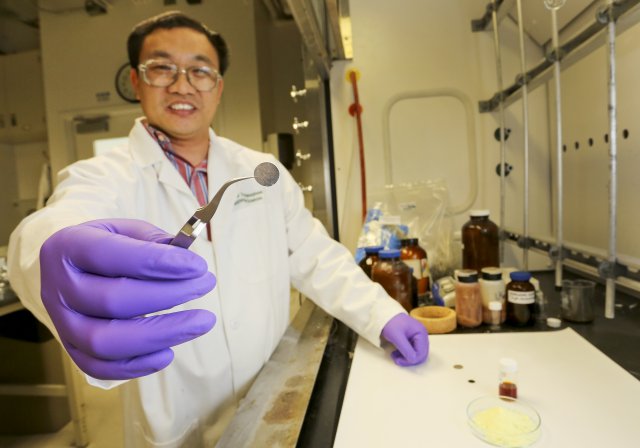 Scientists at the Department of Energy’s Oak Ridge National Laboratory have designed and tested an all-solid lithium-sulphur battery with approximately four times the energy density of conventional lithium-ion technologies that power today’s electronics.
Scientists at the Department of Energy’s Oak Ridge National Laboratory have designed and tested an all-solid lithium-sulphur battery with approximately four times the energy density of conventional lithium-ion technologies that power today’s electronics.
The ORNL battery design, which uses abundant low-cost elemental sulphur, also addresses flammability concerns experienced by other chemistries.
“Our approach is a complete change from the current battery concept of two electrodes joined by a liquid electrolyte, which has been used over the last 150 to 200 years,” said Chengdu Liang, lead author on the ORNL study published this week in Angewandte Chemie International Edition.
Scientists have been excited about the potential of lithium-sulphur batteries for decades, but long-lasting, large-scale versions for commercial applications have proven elusive. Researchers were stuck with a catch-22 created by the battery’s use of liquid electrolytes: On one hand, the liquid helped conduct ions through the battery by allowing lithium polysulfide compounds to dissolve. The downside, however, was that the same dissolution process caused the battery to prematurely break down.
The ORNL team overcame these barriers by first synthesizing a never-before-seen class of sulphur-rich materials that conduct ions as well as the lithium metal oxides conventionally used in the battery’s cathode. Liang’s team then combined the new sulphur-rich cathode and a lithium anode with a solid electrolyte material, also developed at ORNL, to create an energy-dense, all-solid battery.
“This game-changing shift from liquid to solid electrolytes eliminates the problem of sulphur dissolution and enables us to deliver on the promise of lithium-sulphur batteries,” Liang said. “Our battery design has real potential to reduce cost, increase energy density and improve safety compared with existing lithium-ion technologies.”
The new ionically-conductive cathode enabled the ORNL battery to maintain a capacity of 1200 milliamp-hours (mAh) per gram after 300 charge-discharge cycles at 60 degrees Celsius. For comparison, a traditional lithium-ion battery cathode has an average capacity between 140-170 mAh/g. Because lithium-sulphur batteries deliver about half the voltage of lithium-ion versions, this eight-fold increase in capacity demonstrated in the ORNL battery cathode translates into four times the gravimetric energy density of lithium-ion technologies, explained Liang.
The team’s all-solid design also increases battery safety by eliminating flammable liquid electrolytes that can react with lithium metal. Chief among the ORNL battery’s other advantages is its use of elemental sulphur, a plentiful industrial byproduct of petroleum processing.
“Sulphur is practically free,” Liang said. “Not only does sulphur store much more energy than the transition metal compounds used in lithium-ion battery cathodes, but a lithium-sulfur device could help recycle a waste product into a useful technology.”
Although the team’s new battery is still in the demonstration stage, Liang and his colleagues hope to see their research move quickly from the laboratory into commercial applications. A patent on the team’s design is pending.
“This project represents a synergy between basic science and applied research,” Liang said. “We used fundamental research to understand a scientific phenomenon, identified the problem and then created the right material to solve that problem, which led to the success of a device with real-world applications.”
The study is published as “Lithium Polysulfidophosphates: A Family of Lithium-Conducting Sulfur-Rich Compounds for Lithium-Sulfur Batteries,” and is available online here . In addition to Liang, coauthors are ORNL’s Zhan Lin, Zengcai Liu, Wujun Fu and Nancy Dudney.
The research was sponsored by the U.S. Department of Energy, through the Office of Energy Efficiency and Renewable Energy’s Vehicle Technologies Office. The investigation of the ionic conductivity of the new compounds was supported by the Department’s Office of Science.
The synthesis and characterization was conducted at the Center for Nanophase Materials Sciences at ORNL. CNMS is one of the five DOE Nanoscale Science Research Centers supported by the DOE Office of Science, premier national user facilities for interdisciplinary research at the nanoscale. Together the NSRCs comprise a suite of complementary facilities that provide researchers with state-of-the-art capabilities to fabricate, process, characterize and model nanoscale materials, and constitute the largest infrastructure investment of the National Nanotechnology Initiative. The NSRCs are located at DOE’s Argonne, Brookhaven, Lawrence Berkeley, Oak Ridge and Sandia and Los Alamos national laboratories. For more information about the DOE NSRCs, please visit http://science.energy.gov/bes/suf/user-facilities/nanoscale-science-research-centers .
UT-Battelle manages ORNL for the Office of Science. The Office of Science is the single largest supporter of basic research in the physical sciences in the Unite
Photo: Oak Ridge National Laboratory
Source: Oak Ridge National Laboratory

Lithium Solid Sulphur – 4 times more energy density..
Lets do some math.
1.2Ah per gram maintained after 300 charge cycles for LiS battery.
Highest energy in production now for Li-ion is now 260Wh/kg as far as I know about Amicell.
260Wh/3.7V, we get 70.27Ah/kg. That equals to 0.07Ah per gram!
Where comes the 0.14Ah to 0.17Ah per gram? That means 518Wh/kg! Which production Li-ion? I be happy with that.
So that is 17x more capacity (1.2/0.07). But because it has half the voltage compare to Li-ion, the weight saved is as good as 8.5 times! Very good.
Also, for many applications the lower voltage/cell is a great advantage, as that means you can target a pack voltage more precisely for the task (ie finer voltage resolution)… Wonder how this new chemistry works across temperature extremes, how much capacity is lost at higher discharge rates, and how “flat” is voltage during discharge to capacity? These are real world concerns! If this works out, as LiPo’s signaled the beginning of the end of glow & gas engines in the hobby world, these would be the stake in the heart!